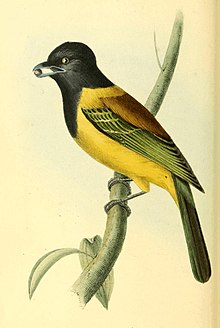
The cotingas are a large family, Cotingidae, of suboscine passerine birds found in Central America and tropical South America. Cotingas are birds of forests or forest edges, that are primary frugivorous. They all have broad bills with hooked tips, rounded wings, and strong legs. They range in size from 12–13 cm (4.7–5.1 in) of the fiery-throated fruiteater up to 48–51 cm (19–20 in) of the Amazonian umbrellabird.

The Tyranni (suboscines) are a suborder of passerine birds that includes more than 1,000 species, the large majority of which are South American. It is named after the type genus Tyrannus. These have a different anatomy of the syrinx musculature than the oscines, hence the common name of suboscines.

Neotropical bellbird is the common name given to passerine birds of the genus Procnias, found in the Neotropics. They are members of the cotinga family. They are all restricted to tropical or subtropical humid forested regions, often in low mountains or foothills. As indicated by their common name, they all have extremely loud calls that are reminiscent of a metal bell being rung.

Ampelion is a genus of passerine birds in the family Cotingidae. It contains the following species:

The kinglet calyptura is a small passerine bird. It is the only member of the genus Calyptura in the family Tyrannidae. It had traditionally been considered a member of the family Cotingidae. It is endemic to Atlantic forest in south-eastern Brazil. For a long time this species was feared to be extinct, as it went unrecorded during the 20th century until two birds were observed in Serra dos Órgãos on several days in October 1996. Since these sightings, there have not been any confirmed records, although at least one recent—but unconfirmed—record exists from near Ubatuba. Consequently, it is considered Critically Endangered by BirdLife International.
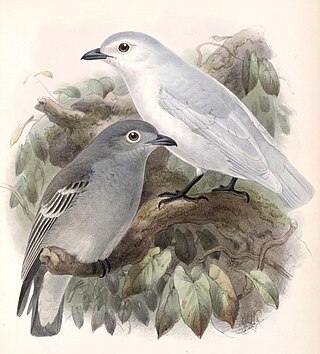
Carpodectes is a genus of passerine birds in the family Cotingidae.

The bare-necked fruitcrow is a species of bird in the family Cotingidae. It is the only member of the genus Gymnoderus. It is found in the Amazon Rainforest, especially near rivers. It is relatively common, but generally rarer and more local north of the Amazon River. Both sexes are overall mainly blackish, but the male has distinctive, large greyish-blue facial- and neck-wattles and greyish-white wings, which flash conspicuously in flight.

Lipaugus is a genus of birds in the family Cotingidae.

The swallow-tailed cotinga is a species of passerine bird in the family Cotingidae. It is the only member of the genus Phibalura.

Phoenicircus is a genus of birds in the family Cotingidae. They have a bright red breast, crown, tail, and rump with the Guianan species having dark brown wings and the black-necked species having black wings. They are frugivores, eating primarily berries and drupes.

Pipreola is a genus of bird in the family Cotingidae. Together with Ampelioides tschudii, they are collectively known as fruiteaters. All are restricted to humid montane or foothill forest in western or northern South America. They are thickset birds with predominantly greenish upperparts. Males of most species have black heads and/or reddish, orange or yellow to the throat, chest or belly.
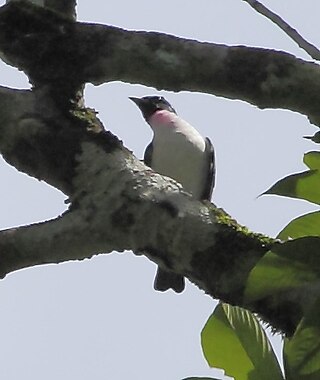
The purple-throated cotinga is a species of bird in the cotinga family, Cotingidae. It is found in the western Amazon rainforest of South America; its range extends from southern Colombia south through eastern Ecuador and Peru and east through extreme northwestern Bolivia and into western Amazonian Brazil. It lives in the canopy or along the borders of humid forest throughout its range. The purple-throated cotinga is monotypic within the genus Porphyrolaema and has no known subspecies. It is one of the smaller cotinga species and expresses strong sexual dimorphism. Males have black upperparts with a bold white wingstripe and white edges to the tertial feathers and a white belly with some black barring on the rear flanks. The throat is a deep purple, giving the bird both its common and scientific names. Females are dark brown with pale buffy margins on the upperparts, buffy cinnamon with black barring on the underparts, and rufous on the throat. The male has a powerful voice.
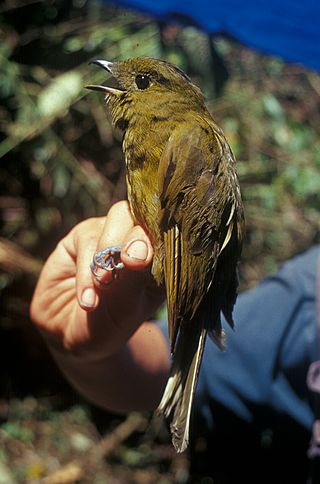
Snowornis is a genus of birds in the family Cotingidae. The species were formerly included in the genus Lipaugus,

The black-and-gold cotinga is a species of bird in the family Cotingidae. It is endemic to humid Atlantic Forest in the highlands of the Serra do Mar in south-eastern Brazil. It is threatened by habitat loss, but remains common within several national parks, e.g. Serra dos Órgãos and Itatiaia. Males are highly vocal, and their loud, piercing whistle is frequently heard. It is strongly sexually dimorphic. Except for a bright yellow wing-speculum, males are superficially similar to the male common blackbird, while the far less conspicuous females are overall olive. The female resemble both sexes of the only other member of the genus, the grey-winged cotinga, but is larger, has a thicker bill, and yellowish-olive remiges.

The grey-winged cotinga is a species of bird in the family Cotingidae. It is endemic to Brazil where it is restricted to the Serra dos Órgãos and Serra do Tinguá in Rio de Janeiro State. Its natural habitat is tropical moist montane forest.
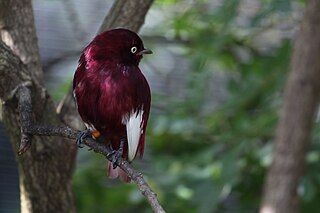
Xipholena is a genus of passerine birds in the family Cotingidae.

Cotinga is a genus of passerine birds belonging to the cotinga family, Cotingidae. It contains seven species that are found in tropical rainforest in South and Central America from southern Mexico to south-east Brazil. They feed mainly on fruit and forage high in trees.

Tityridae is family of suboscine passerine birds found in forest and woodland in the Neotropics. The 45 species in this family were formerly spread over the families Tyrannidae, Pipridae and Cotingidae. As yet, no widely accepted common name exists for the family, although tityras and allies and tityras, mourners and allies have been used. They are small to medium-sized birds. Under current classification, the family ranges in size from the buff-throated purpletuft, at 9.5 cm (3.7 in) and 10 grams, to the masked tityra, at up to 24 cm (9.5 in) and 88 grams. Most have relatively short tails and large heads.

Tyrannides is a clade of passerine birds that are endemic to the Americas. The group likely originated in South America during the Eocene, about 45 million years ago.

The Apolo cotinga or palkachupa cotinga is a species of passerine bird in the family Cotingidae. It is a member of the genus Phibalura.
